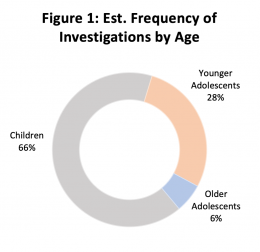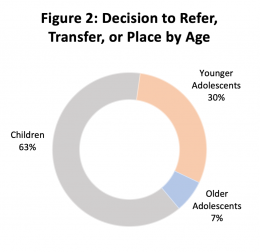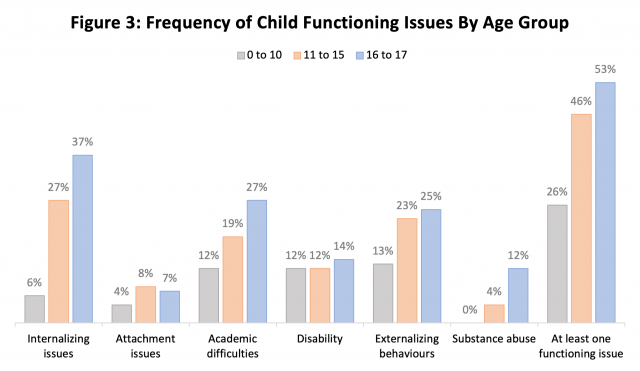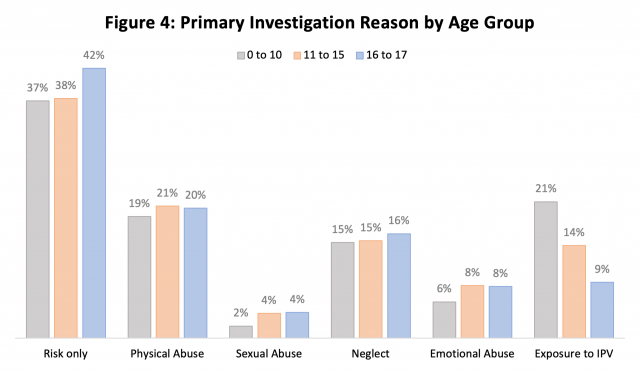Alman, I., Lyon, O. & King, B. (2020). Characteristics of Maltreatment-Related Investigations in Ontario in 2018 Involving Adolescents aged 16 to 17. CWRP Information Sheet #. Toronto, ON: Canadian Child Welfare Research Portal.
Introduction
This Information Sheet examines the characteristics of older adolescents, aged 16 to 17, involved in maltreatment-related investigations conducted by child welfare agencies across Ontario in 2018. The following figures were derived from data collected during the Ontario Incidence Study of Reported Child Abuse and Neglect 2018 (OIS-2018). The OIS-2018 is the sixth provincial study to examine the incidence of reported child maltreatment and the characteristics of children and families investigated by child welfare authorities in Ontario [1]. This Information Sheet includes descriptive characteristics and frequencies relevant to older adolescents (aged 16-17), as indicated by child welfare workers following a maltreatment-related investigation. Investigation characteristics involving older adolescents (aged 16-17) were also compared with those involving younger adolescents (aged 11-16) and children (aged 0-10) to examine possible differences across distinct developmental age groups.
Child welfare provision in Ontario is legislated under the Child, Youth and Family Services Act, for which an amendment was enacted in 2017 [2]. The amendment included the mandated increase of the Age of Protection to include youth aged 16 to 17. This age group had been excluded from child welfare services prior to the amendment. Under the expanded Age of Protection, older adolescents (aged 16-17) involved in a maltreatment-related investigation may access support services while living in the family home or outside the home in Kinship care, Customary care, or Voluntary Youth Service Agreements [2]. This Information Sheet provides data on maltreatment-related investigations in Ontario unavailable prior to amended Age of Protection.
Findings
In Ontario in 2018, there were an estimated 158,476 maltreatment-related investigations conducted by child protection services for reports involving children and youth aged 0-17 [1]. For this Information Sheet, investigations involving children and youth living independently and community caregiver investigations were excluded. This resulted in a sample of 155,649 maltreatment-related investigations involving children and youth living in the home with their primary caregivers at the time of the investigation. For this analysis, sample data was coded into three categories to highlight and compare differences across developmental age: older adolescents (aged 16-17), younger adolescents, (aged 11-15), and children (aged 0-10).
Figure 1 presents the estimated number of maltreatment-related investigations across the three age categories. In Ontario in 2018, there were an estimated 9,417 maltreatment-related investigations involving older adolescents (aged 16-17), and 43,782 maltreatment-related investigations involving younger adolescents (aged 11-15). Together, adolescents (age 11-17) represented an estimated 53,199 (or 34%) of maltreatment-related investigations1. The remaining 102,450 maltreatment-related investigations involved children under age 10.
Figure 2 displays the proportion of maltreatment-related investigations across age categories where the outcome of investigative decision-making resulted in transfers to ongoing child welfare services, referrals made to internal or external services, or an out of home placement at the conclusion of the investigation. In Ontario in 2018, an estimated 4,726 maltreatment-related investigations involving older adolescents (age 16-17) resulted in a referral, transfer, or placement during the investigation [1].


Figure 3 illustrates frequencies of functioning issues as indicated during maltreatment-related investigations involving children, younger adolescents, and older adolescents. In Ontario in 2018 and compared to younger adolescents and children, investigations involving older adolescents were more likely to have been identified as struggling with internalizing issues (37%), academic difficulties (27%), disability (14%), externalizing behaviours (25%), substance abuse (12%), and having at least once functioning issue (53%) [1].

Figure 4 compares the primary reason for initiating the investigation (risk only, physical abuse, sexual abuse, neglect, emotional maltreatment, or exposure to intimate partner violence [IPV]) across the three age categories [1]. For investigations involving older adolescents (aged 16-17), risk only investigations were notably higher, while those focused on exposure to IPV were substantially lower than for the other two age groups.

Methodology
The OIS-2018 employed a multi-stage sampling design to select a representative sample of 18 child welfare agencies across Ontario. Selected agencies were then sampled over a three-month period in Autumn of 2018. Case data were collected directly from child protection workers following the conclusion of their investigations via a standardized online data collection instrument. Design weights were applied to selected cases to derive provincial annual incidence estimates. The estimates presented in the OIS-2018 report are based on data collected from a representative sample of 7,590 selected cases which account for a provincial annual estimate of 158,476 maltreatment-related investigations conducted in Ontario in 2018.
In Ontario, maltreatment-related investigations may be conducted for a specific incident of maltreatment or for a concern regarding risk of maltreatment only. For the OIS-2018, data was collected regarding primary forms of maltreatment investigated (i.e., concern of abuse or neglect) as well as the level of substantiation for that maltreatment (substantiated, suspected, or unfounded). Thirty-three forms of maltreatment were listed on the online data collection instrument which were condensed into five broad categories: physical abuse (e.g., hit with hand), sexual abuse (e.g., exploitation), neglect (e.g., educational neglect), emotional maltreatment (e.g., verbal abuse or belittling), and exposure to intimate partner violence (e.g., direct witness to physical violence between caregivers). Workers recorded the primary concern for the investigation and could also record secondary and tertiary concerns.
For risk investigations, child protection workers determined whether the child was at risk of future maltreatment based on the presence of identified risk factors (i.e., unstable housing, caregiver substance abuse, etc.). Child protection workers may then decide whether a child was at risk of future maltreatment (confirmed risk), that the child was not at risk of future maltreatment (unfounded risk), or that the future risk of maltreatment was unknown.
Workers were asked to provide information on various other aspects of their investigations, including the characteristics of the household, caregivers, and children, any history of previous child welfare reports or investigations, or existing child welfare service dispositions including transfers to ongoing services or referrals made to internal or external services.
Limitations
The OIS collects information about children and families directly from child protection workers following the completion of their maltreatment-related investigation regarding a report of possible child abuse or neglect, or risk of future maltreatment. The scope of the study is limited to the extent of information available to the worker at the time of data collection and does not include information about unreported maltreatment nor about cases investigated by the police only. Information on cases opened outside of the 3-month data collection period were not included. Additionally, reports that were made to child welfare authorities but were screened out (i.e., not opened for investigation) were excluded. Finally, the study did not track long term service events that occurred beyond the initial investigation.
Three limitations to the estimation method used to derive provincial annual estimates should be noted. The agency size correction uses service volume as a proxy for agency size; this does not account for potential variation in investigations across agencies. The annualization weight corrects for seasonal fluctuations in the volume of investigations, but it does not correct for seasonal variations in types of investigations conducted. Finally, the annualization weight includes cases that were investigated more than once in the year resultant of the case being re-opened following a first investigation completed earlier in the same year. Accordingly, the weighted annual estimates represent the number of child maltreatment-related investigations in Ontario in 2018, rather than the number of investigated children.
Comparisons across OIS reports must be made with caution. The forms of maltreatment tracked by each cycle were modified to consider changes in investigation mandates and practices. Comparisons across cycles must take into consideration the fact that the OIS-2008 was the first to explicitly track risk-only investigations.
For a full description of OIS-2018 methodology, please see the OIS-2018 report [1].
[1] Fallon, B., Filippelli, J., Lefebvre, R., Joh-Carnella, N., Trocmé, N., Black, T., ... Stoddart, J. (2020). Ontario Incidence Study of Reported Child Abuse and Neglect-2018 (OIS-2018). Toronto, ON: Child Welfare Research Portal.
[2] Child, Youth and Family Services Act 2017, SO 2017, c. 14, Sched. 1.
